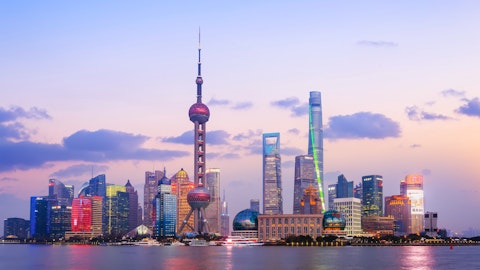Eric Shen: [Foreign Language] [Interpreted] Okay. In terms of the guidance for Q3, the 0% to 5% revenue growth is primarily because of the slow momentum in slow — relatively slow season for apparel categories. And you know, we are pretty strong in apparel and when we enter into Q3, we will have lower growth. But the GMV growth is actually much better, but apparel naturally carry higher return rates. And partially — and of course, we also find that consumers are more cautious about their spending. And when they place their orders, they have to think over and over and then the return rate would be trending higher. Another reason for return rate is that we provide a worry-free services for return to exchanges and a lot of customers appreciate our service.
And this is part of our initiative to actually to provide excellent services to customers for the long-term to gain their customer taking their mind share. So — and it’s already built in our business model, and we actually don’t care too much about its short-term impact. And going into Q4, we’re definitely returning to a stronger growth rate. The base effect is also in play, as I mentioned, because last year, COVID impact was actually more not meaningful in the third quarter. So we probably don’t have an easy comp to compare. For the longer term, of course, we are looking at a very much healthier growth rate we still want to leverage our value proposition in discount retail for branded products and to grow our business — and in — already in this quarter, we are starting to prudently increase our spending — our marketing spending to try to capture the opportunity to grow more customers.
So we are we are confident that we can grow better than the guidance we provided.
Operator: Thank you. Our next question comes from Eddy Wang from Morgan Stanley. Please ask your question, Eddy.
Eddy Wang: [Foreign Language] Thank you, management for taking my question. My question is also regarding the return rate. Can you share with us the trend of the return rate in first quarter, second quarter and the third quarter so far, because we have seen that if you look at the fulfillment rate in the second quarter, actually, we see a little bit higher than the first quarter. And so should we expect that this fulfillment rate — expense ratio to a little bit higher going forward? Thank you.
Eric Shen: [Foreign Language] [Interpreted] Okay. In terms of the gap between revenue and GMV, actually, we have seen return rate is starting to trend up from the first quarter. And in the second quarter, it’s going up quite significantly. So we expect that Q3 would maintain a similar level as Q2 and Q4 is [Indiscernible] potentially could be higher, but it should not be much higher, because we have started to take some initiatives to bring the return rate to a more normalized level. But having said that, the gap between our revenue and GMV that we have seen for the past several quarters could be the benchmark for your estimate for future revenue versus GMV, it’s going to be a little bit different than the level we have seen in the past several years.
And return rate, we had mentioned earlier, one of the reasons is that consumers — many consumers at VIPs, they love to shop on our platform. They enjoy trying on and if they are not satisfied, they would just return or exchange over through our very free services. And another reason is that potentially, consumers are more cautiously on spending nowadays, because they manage their household budgets more carefully. And in terms of fulfillment expense, return rates is part of the reason that fulfillment may trended higher in the second quarter. But it’s the cost associated with the returns or exchanges mostly delivery cost back and forth. So it’s just a part of the model — the business model we’re building it’s for the full-year or the longer term, we think fulfillment expense ratio is still manageable, not going to be extremely high.
Probably some slower season is going to be high, but in peak season especially for apparel, it is totally manageable.
Operator: Thank you. Our next question comes from the line of Andre Chang from JP Morgan. Please ask your question, Andre.
Andre Chang: [Foreign Language] I have a question for shareholder return and share buyback. I noticed that the company has bought back $350 million round of ADS this quarter versus current program of $1 billion over two years. So the pace is significantly faster than the average pace of the program. And also the buyback amount is equivalent to our free cash flow. So my question is about what’s the philosophy and the strategy of our share buyback and the shareholder return can management share with us what the principle for you to buy at what kind of level, what kind of pace, so investors can understand the shareholder return you can get from here? Thank you.
Eric Shen: [Foreign Language] [Interpreted] Yes. Okay. Actually, we don’t have a specific philosophy or rules as to the buyback program. We just buyback when the share price is much underappreciated, as compared to fair value. So we don’t have a specific pace. We are just very committed.
Mark Wang: Okay. This is Mark. Thanks for your question. Yes, we would like to return value to our shareholders. So we have been steadily executing our buyback programs. And as of the second quarter, we have utilized around $435 million of our current $1 billion share repurchase program. And that means starting from second quarter 2021, we have returned a total of about $2 billion to our shareholders as of the second quarter of 2023. I think we will continue to execute this program from time-to-time. And yes, so another thing is that just mentioned by Eric, that we will also focus on the share price and also our enterprise values, okay? If we believe that the share price — we believe the market cap is really below the value, and then we will do our share buyback from time-to-time. Thank you.
Operator: Thank you. Our next question comes from Jialong Shi from Nomura. Please ask your question, Jialong.


